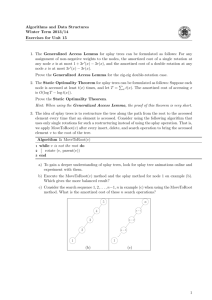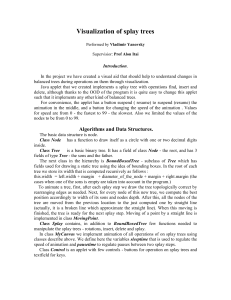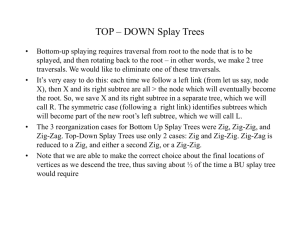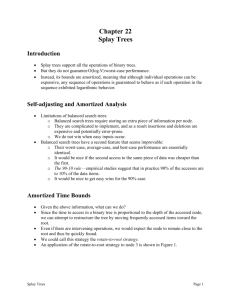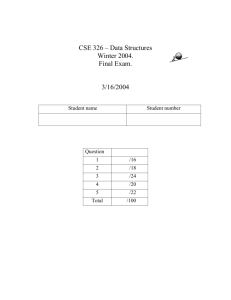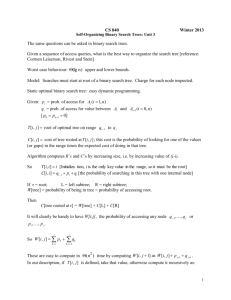1 Splay Tree A splay tree is a type of balanced binary search tree
advertisement
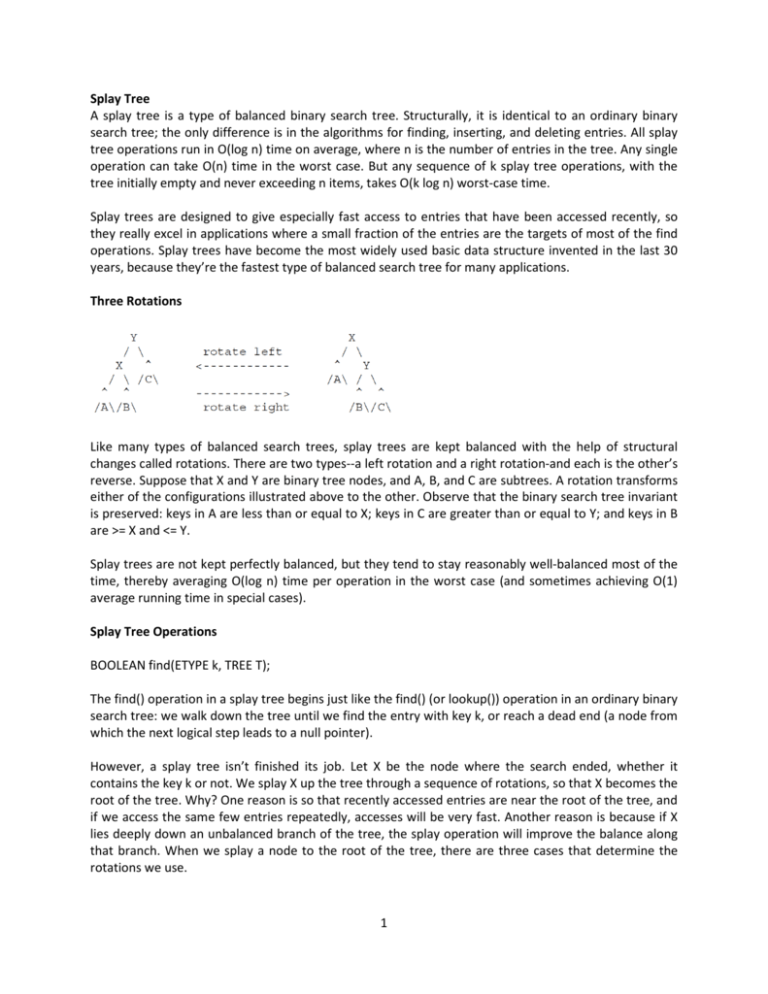
Splay Tree A splay tree is a type of balanced binary search tree. Structurally, it is identical to an ordinary binary search tree; the only difference is in the algorithms for finding, inserting, and deleting entries. All splay tree operations run in O(log n) time on average, where n is the number of entries in the tree. Any single operation can take O(n) time in the worst case. But any sequence of k splay tree operations, with the tree initially empty and never exceeding n items, takes O(k log n) worst-case time. Splay trees are designed to give especially fast access to entries that have been accessed recently, so they really excel in applications where a small fraction of the entries are the targets of most of the find operations. Splay trees have become the most widely used basic data structure invented in the last 30 years, because they’re the fastest type of balanced search tree for many applications. Three Rotations Like many types of balanced search trees, splay trees are kept balanced with the help of structural changes called rotations. There are two types--a left rotation and a right rotation-and each is the other’s reverse. Suppose that X and Y are binary tree nodes, and A, B, and C are subtrees. A rotation transforms either of the configurations illustrated above to the other. Observe that the binary search tree invariant is preserved: keys in A are less than or equal to X; keys in C are greater than or equal to Y; and keys in B are >= X and <= Y. Splay trees are not kept perfectly balanced, but they tend to stay reasonably well-balanced most of the time, thereby averaging O(log n) time per operation in the worst case (and sometimes achieving O(1) average running time in special cases). Splay Tree Operations BOOLEAN find(ETYPE k, TREE T); The find() operation in a splay tree begins just like the find() (or lookup()) operation in an ordinary binary search tree: we walk down the tree until we find the entry with key k, or reach a dead end (a node from which the next logical step leads to a null pointer). However, a splay tree isn’t finished its job. Let X be the node where the search ended, whether it contains the key k or not. We splay X up the tree through a sequence of rotations, so that X becomes the root of the tree. Why? One reason is so that recently accessed entries are near the root of the tree, and if we access the same few entries repeatedly, accesses will be very fast. Another reason is because if X lies deeply down an unbalanced branch of the tree, the splay operation will improve the balance along that branch. When we splay a node to the root of the tree, there are three cases that determine the rotations we use. 1 1. X is the right child of a left child (or the left child of a right child):let P be the parent of X, and let G be the grandparent of X. We first rotate X and P left, and then rotate X and G right, as illustrated below. The mirror image of this case where X is a left child and P is a right child--uses the same rotations in mirror image: rotate X and P right, then X and G left. Both the case illustrated above and its mirror image are called the "zig-zag" case. 2. X is the left child of a left child (or the right child of a right child): the ORDER of the rotations is REVERSED from case 1. We start with the grandparent, and rotate G and P right. Then, we rotate P and X right. The mirror image of this case--where X and P are both right children--uses the same rotations in mirror image: rotate G and P left, then P and X left. Both the case illustrated below and its mirror image are called the "zig-zig" case. We repeatedly apply zig-zag and zig-zig rotations to X; each pair of rotations raises X two levels higher in the tree. Eventually, either X will reach the root (and we’re done), or X will become the child of the root. One more case handles the latter circumstance. 3. X’s parent P is the root: we rotate X and P so that X becomes the root. This is called the "zig" case. Here’s an example of "find(7)". Note how the tree’s balance improves. 2 By inspecting each of the three cases (zig-zig, zig-zag, and zig), you can observe a few interesting facts. First, in none of these three cases does the depth of a subtree increase by more than two. Second, every time X takes two steps toward the root (zig-zig or zig-zag), every node in the subtree rooted at X moves at least one step closer to the root. As more and more nodes enter X’s subtree, more of them get pulled closer to the root. A node that initially lies at depth d on the access path from the root to X moves to a final depth no greater than 3 + d/2. In other words, all the nodes deep down the search path have their depths roughly halved. This tendency of nodes on the access path to move toward the root prevents a splay tree from staying unbalanced for long (as the example below illustrates). TREE insert(ETYPE k, TREE T); insert() begins by inserting the new entry k, just like in an ordinary binary search tree. Then, it splays the new node to the root. void remove(ETYPE k, TREE *pT) An entry having key k is removed (or deleted) from the tree, just as with ordinary binary search trees. Recall that the node containing k is removed if it has zero or one children. If it has two children, the 3 node with the next higher key is removed instead. In either case, let X be the node removed from the tree. After X is removed, splay X’s parent to the root. Here’s a sequence illustrating the operation remove(2). In this example, the key 4 moves up to replace the key 2 at the root. After the node containing 4 is removed, its parent (containing 5) splays to the root. If the key k is not in the tree, splay the node where the search ended to the root, just like in a find() operation. Check out the following links for splay tree animation: http://www.ibr.cs.tu-bs.de/courses/ss98/audii/applets/BST/SplayTree-Example.html http://techunix.technion.ac.il/~itai/ 4
